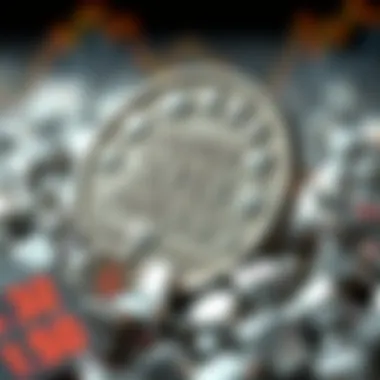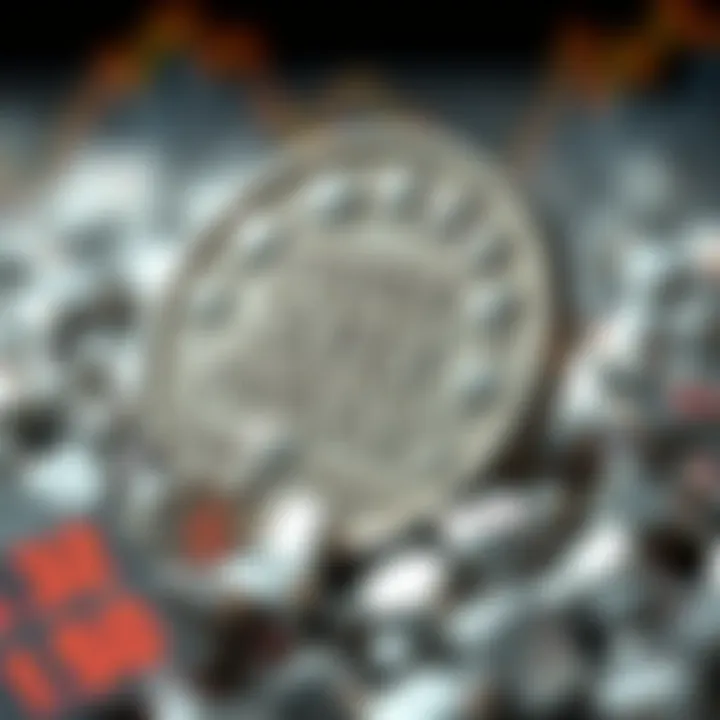Analyzing Historical Trends in Silver Prices


Intro
Silver has captivated human interest for centuries. It is much more than just a shiny metal used for jewelry or industrial applications; it possesses a rich history intertwined with economics, culture, and investment. The fluctuations in silver prices create a narrative that reflects broader market movements, economic upheavals, and political tensions. In this article, we will journey through the winding roads of silver's past and present, exploring how its price has been shaped through various influences.
Understanding these dynamics is crucial for anyone considering silver as a financial asset. This exploration aims to equip investors, analysts, and anyone curious about market trends with the knowledge necessary to navigate the complexities of silver trading. Whether you are looking for short-term strategies or formulating a long-term investment plan, knowing the historical context will aid you in making informed decisions.
The discussion will begin with defining essential investment terms, providing a glossary that tackles the often complex jargon that can overshadow straightforward investment strategies. From there, we will delve into expert insights, such as market trends and tips for prudent investment practices. This will provide a comprehensive framework to understand the marketplace and, ultimately, the price of silver.
Prelude to Silver Investment
In recent years, silver has gained traction as an essential investment vehicle, not just as a precious metal but also as a strategic asset within financial portfolios. Understanding silver's role in investment is crucial for anyone seeking to diversify their holdings or hedge against market uncertainties.
The Role of Silver in Financial Markets
Silver serves multiple functions within the financial landscape. As a commodity, it often mirrors trends seen in gold but holds its unique characteristics due to various factors. Silver is not just a safe haven in economic turmoil; it also finds utility in numerous industries, such as electronics and solar energy, which adds layers to its market value. Investors often look at silver as an alternative investment—a bridge between traditional assets and emerging market opportunities. For instance, during periods of inflation or currency devaluation, silver becomes a compelling asset for those wishing to enhance their portfolios with options that might resist inflationary pressures.
The dynamics in the silver market can shift quickly due to demand in both industrial applications and consumer preferences, making it a notable player in the investment world. Investors presently focusing their energies on financial markets would undoubtedly benefit from understanding this metal's unique standing and the circumstances that can drive its price fluctuations.
Why Invest in Silver?
Investing in silver is appealing for many reasons, each contributing to its allure as a valuable financial asset. Here’s why one might consider adding silver to their portfolio:
- Hedge Against Inflation: Silver’s inherent value tends to increase during inflationary periods, making it a go-to asset for those concerned about currency depreciation.
- Industrial Demand: With use in technology, automotive, and healthcare, the industrial demand for silver is a powerful driver, often leading to price appreciation that outstrips traditional commodities.
- Portfolio Diversification: By adding silver, investors can protect against volatility in other markets, creating a balanced approach to asset management.
- Historical Stability: Over decades, silver has shown resilience in times of economic uncertainty, making it an attractive choice for investors seeking stable returns over the long term.
In summary, engaging with silver offers a multifaceted investment strategy. Its combination of industrial utility and traditional safe-haven characteristics positions it as more than just a metal; it becomes an integral part of forming a robust financial strategy. Understanding how silver operates within the market, as well as its advantages and challenges, can empower investors to make informed decisions.
The Historical Context of Silver Pricing
Understanding the price of silver isn’t just about numbers on a chart; it’s about weaving together a rich tapestry of historical events, economic policies, and societal shifts. Silver has transcended mere commodity status to become an instrument of wealth, preservation, and even cultural symbolism. This section unpacks the layers beneath silver pricing, establishing a foundation for the trends to come. By dissecting crucial periods in history—from silver's integral role in early economies to how various monetary standards have shaped its value—we uncover insights that not only inform investors but also contextualize silver’s place in financial history.
Silver Prices in the Pre-20th Century
In the days before the dawn of the 20th century, silver was akin to a bedrock of value. Many economies adopted silver as a primary currency around the world, particularly in regions where gold was scarce or too precious to circulate freely. The reality was, by the late 1800s, silver coins were common in daily transactions, fostering trade and prosperity.
Prices were often dictated by the market's ebb and flow, influenced by factors like mining yields, technological advancements in extraction, and the discovery of new silver deposits. For instance, the discovery of the Comstock Lode in Nevada during the 1850s marked a pivotal moment in silver production which, in turn, altered pricing structures dramatically.
Moreover, this era painted silver not only as a metal of commerce but also a symbol of status. People hoarded it, revered it, or even traded it. However, in a deluge of market activities, prices could fluctuate wildly from one year to the next.
The Impact of the Gold Standard
As the world transitioned to the 20th century, the adoption of the gold standard began to reshape the financial landscape significantly. Countries like the United States, France, and the United Kingdom tied their currencies directly to gold reserves, effectively sidelining silver in this monetary play. While the gold standard brought with it a sense of economic stability, silver began to dwindle in influence.
The ramifications were profound. For silver mining industries and traders, this created unease, as they grappled with a dual economy where silver’s backing was diminished. Prices sank as demand plateaued, driven largely by legislation that favored gold over silver. The 1873 Coinage Act notably ended the minting of silver coins, a decision that had a chilling effect on silver valuations and exacerbated the volatility we see reflected in those years.
"The gold standard may have been stable, but it came at the cost of silver’s historical eminence in world markets."
The Great Depression’s Effects on Silver
Fast forward to the late 1920s, and we encounter the Great Depression—an epoch that not only reshaped economies but transformed the behavioral psychology of investors and traders alike. The economic collapse resulted in a rush toward traditional safe havens. Silver, which had been cast aside during the gold standard era, found a measure of renewed value as investors sought stability.


However, the bottom line was that the Great Depression left silver markets in disarray. Prices plummeted, buoyed only by speculative investments, but overall sentiment favored hoarding precious metals. The price of silver in the early 1930s dipped to its lowest ebb, hovering around 29 cents per ounce, a stark contrast to the highs previously seen.
The intersection of economic anxiety and silver's historical significance sets the stage for understanding today’s fascination with this versatile metal. Today, investors armed with historical knowledge can navigate market uncertainties with a deeper understanding, informed by lessons learned from the past.
Trends and Patterns in Silver Prices Over the Decades
Understanding trends and patterns in silver prices over the decades provides a crucial backdrop that investors can leverage for informed decision-making. This journey through time highlights that silver is not just a shiny metal; it's a barometer of economic sentiment, influenced by myriad factors from technological advancements to geopolitical instability. By analyzing past trends, one can draw parallels to current market dynamics, allowing for more strategic investments.
Silver Prices in the 1970s and 1980s
The 1970s marked a significant period for silver, characterized by soaring prices primarily due to the energy crisis and rampant inflation. Between 1971 and 1980, silver prices skyrocketed from around $1.50 to over $50 per ounce. This surge can largely be attributed to the financial uncertainty stemming from major events like the Vietnam War and the Arab-Israeli conflict, which drove investors towards precious metals as a safe haven.
The Hunt brothers’ attempt to corner the silver market in 1979 also created waves, contributing to dramatic price spikes. This situation culminated in what was referred to as Silver Thursday in March 1980, when prices plummeted almost overnight due to government interventions and market corrections, leaving many investors reeling.
Key takeaways from this period include the importance of geopolitical factors and speculative trading, which continue to influence silver prices today.
Price Fluctuations in the 1990s
The 1990s presented a different climate for silver investments. Following the tumultuous ‘70s and ‘80s, prices stabilized to some extent, hovering mostly between $4 and $7 per ounce. The waning influence of inflation and a broader shift toward economic stability in the Western world played a pivotal role.
However, this decade did see notable fluctuations surrounding financial market developments. The introduction of new technologies and the rise of the internet led to speculation related to industrial demand for silver. Moreover, as more markets became intertwined globally, silver began to reflect not just domestic but also international economic trends. Investors learned to pay attention to shifts in technology and manufacturing, knowing that these factors significantly affected silver’s utility and, consequently, its price.
The 2000s: A Bull Market for Silver
As the millennium turned, silver entered a new bull market era. From 2001 to 2011, prices climbed from approximately $4.50 to nearly $48 per ounce, driven by a combination of factors, including a resurgence in industrial demand and growing investor interest in precious metal as an asset class. The 2008 financial crisis played a pivotal role, emphasizing silver as a hedging option against market volatility.
This decade also marked significant technological advancements in the solar industry, further driving silver's demand due to its essential role in photovoltaic cells. The recognition of silver as a dual-purpose asset—both as an investment and in various industrial applications—reshaped how investors perceived its value in financial markets.
Recent Trends from to Present
From 2010 onward, silver has experienced both ups and downs, reflecting broader market trends and investor sentiment. Prices peaked around $49 in April 2011, only to retreat significantly in the following years. Factors contributing to these fluctuations include economic recovery, changes in industrial demand, and fluctuations in investor interest. The COVID-19 pandemic and subsequent economic uncertainty ushered in a renewed interest in precious metals as safe-haven investments.
As we entered the 2020s, silver prices continued to be influenced by a mix of economic indicators and geopolitical uncertainties. Furthermore, the rise of retail trading platforms allowed newer generations of investors to engage with silver, injecting fresh dynamics into the market.
In summary, analyzing silver's price trends through the decades reveals an intricate narrative impacted by various factors, allowing investors to glean insights that can inform their strategies moving forward.
Factors Influencing Silver Prices
Understanding the factors that influence the price of silver is crucial for anyone who wishes to delve into the world of investing in this precious metal. Various elements play a significant role in shaping the silver market.\n\nDespite being a physical asset, silver's price is swayed by intangible forces, making it particularly fascinating for investors and analysts alike. Grasping these dynamics not only empowers one to anticipate market movements but also enables better-informed choices in investment strategies.
Global Economic Indicators
Global economic indicators serve as fundamental barometers of market health. These metrics encompass various data points, such as inflation rates, unemployment statistics, and GDP growth. An increase in inflation, for instance, usually propels investors toward precious metals like silver as a hedge against currency devaluation. When interest rates are low, the opportunity cost for holding non-yielding assets like silver diminishes, often resulting in increased demand.
Moreover, macroeconomic trends spurred by economic policies and performances in leading economies (such as the United States and China) add layers to the silver pricing puzzle. Economic recoveries or downturns can produce notable swings in demand, which in turn influence silver’s price trajectory.
Geopolitical Events and Their Impact
Geopolitical events can quicken or decelerate price changes dramatically. Take, for example, regional conflicts or international trade negotiations. These scenarios often result in market uncertainty, causing investors to flock to safe-haven assets, including silver. The fear of instability—whether due to wars, sanctions, or natural disasters—pushes demand up, which can cause prices to jump.


Additionally, policy decisions made by powerful nations can create ripples felt globally. A tangible example would be the volatility seen during the U.S.-China trade tensions, when silver prices fluctuated in response to market reactions. Thus, staying attuned to world affairs becomes essential for anyone looking to invest in silver.
Supply and Demand Dynamics
The fundamentals of supply and demand create a balancing act that dictates silver prices. Silver is not just a trade commodity; it's also used extensively in industrial applications like electronics, photography, and renewable energy. Increased demand in sectors such as solar panel production can lead to price increases, especially when supply struggles to keep pace.
In contrast, an oversupply could lead to plunging prices. Factors that contribute to silver supply include mining output, recycling rates, and, quite importantly, technological advancements that might affect extraction methods. When mining operations hit output records but demand wanes, the result can be detrimental for investors and stakeholders alike.
Currency Strength and Silver Prices
The strength of currency, particularly the U.S. dollar, holds relative importance in silver trading. Typically, a stronger dollar might signal a decrease in precious metals prices, as silver becomes more expensive for buyers using other currencies. Conversely, a weaker dollar often makes silver more attractive, thus driving its demand.
This relationship forms a cycle; as dollar strength fluctuates due to economic conditions or Federal Reserve policies, so too does the interest in silver as an alternative investment. Analysts closely monitor forex trends to gauge potential silver price movements.
"Understanding the interplay of these factors can make the difference between a mediocre investment and a remarkable one."
Investment Strategies In Silver
Investing in silver may seem straightforward, but when you delve deeper, you realize that a well-thought-out strategy can make the difference between a missed opportunity and a lucrative asset. The importance of exploring various investment strategies in silver cannot be overstated. With the price of silver being notorious for its volatility, a strategic approach not only mitigates risk but also allows investors to take advantages of market fluctuations effectively. Each strategy carries its own benefits and considerations, catering to different financial goals and risk tolerances.
Direct Ownership of Physical Silver
Owning actual bars or coins of silver is often perceived as the purest form of silver investment. This strategy resonates with those who prefer tangible assets over digital representations. Direct ownership grants investors a sense of security; after all, one can hold their investment in their own hands. However, there are nuances to consider.
For example, storing physical silver requires secure locations to prevent theft or damage. Moreover, the liquidity of physical silver may not match that of other investment options, as selling can take time and might involve dealer markups. Investors should also note that while silver has intrinsic value, the market prices can fluctuate based on various external factors, including economic conditions and demand for industrial use.
"Buying physical silver is like having a safety net you can touch; it's tangible even when the markets go haywire."
Silver ETFs and Mutual Funds
Exchange-Traded Funds (ETFs) and mutual funds present a more accessible way of investing in silver without the complexities of storage or security. These funds pool resources from multiple investors to invest in silver bullion or miner stocks, offering certain advantages. Accessibility is a significant benefit—one can start investing with relatively small amounts, making it easier for new investors to dip their toes into the silver market.
Additionally, silver ETFs can be traded throughout the day just like stocks, providing enhanced liquidity. However, it’s vital to scrutinize the expenses associated with these funds. Management fees can eat into profits, especially for long-term investors. Understanding the underlying assets of these funds is also crucial; some may focus on physical silver, while others might invest heavily in silver mining companies, which carry their own operational risks.
Silver Futures and Options Trading
For those who are more experienced and willing to embrace higher risk, silver futures and options trading can offer significant profit potential. Futures contracts allow investors to buy silver at a predetermined price at a future date. This type of investment can yield substantial returns if the price of silver rises; however, if the price falls, the losses can be equally great.
Options trading further expands the toolbox of strategies, allowing investors to speculate on the future price movement of silver with limited risk compared to futures. It’s worth noting that while these strategies can appear appealing, they demand a good grasp of market trends and an unyielding commitment to ongoing education and analysis. As such, they may not be suitable for every investor but could align well with those who are adept at reading market signals and managing risks.
Silver vs Other Precious Metals
When delving into the world of precious metals, silver often finds itself compared to its more illustrious counterparts—gold, platinum, and palladium. Understanding how silver stacks up against these metals is crucial for investors navigating the complexities of the market. This section aims to dissect these comparisons, highlighting the unique benefits and considerations associated with silver as an investment.
Comparative Analysis with Gold
Gold and silver have been intertwined in human history, serving as both currency and a store of value. Historically, gold has commanded a higher price due to its rarity and status as a safe haven during economic turmoil. However, silver presents unique advantages worth noting.
- Affordability: Silver is significantly cheaper than gold, allowing a wider range of investors to participate in the market. This accessibility can lead to increased interest during periods of economic uncertainty, as more people seek to invest in tangible assets.
- Industrial Demand: Unlike gold, silver has extensive industrial applications, from electronics to solar panels. This demand can create positive price momentum, especially in developing sectors that utilize silver extensively.
- Volatility: Silver tends to be more volatile than gold, which can be a double-edged sword. Price swings can yield quick profits, but they also pose risks; investors must be aware of their tolerance for risk before diving into silver.


In summary, while gold holds its ground as the king of precious metals, silver’s unique characteristics provide an attractive alternative, especially for those looking to diversify their portfolio.
Platinum and Palladium: A Contrast
Platinum and palladium are often overshadowed by gold and silver. These metals, primarily used in automotive production and other industrial applications, have their own narratives to tell.
- Supply Constraints: Both platinum and palladium face supply challenges that can drive prices up. For instance, many of the world’s platinum mines are located in politically unstable regions, leading to concerns about future availability.
- Market Application: Silver has broader industrial applications than platinum and palladium, making it a less specialized investment. Investors seeking exposure to industrial growth might prefer silver, due to its wide-ranging uses.
- Price Relationships: The price of platinum and palladium can be closely tied to the automobile industry’s performance. In contrast, silver’s price might respond differently due to its less concentrated use in a single industry.
"In the ever-fluctuating world of precious metals, understanding the intricate relationships between these assets can equip investors with the knowledge needed to make informed decisions."
For more insights about precious metals, refer to resources like Britannica or Wikipedia.
Overall, as investors mull over their options in the precious metals market, keeping a keen eye on the comparative landscapes of silver, gold, platinum, and palladium will prove invaluable.
The Future of Silver Investment
The future of silver as an investment is a topic that carries immense weight, crucial for investors and analysts alike. As we navigate through the uncertain terrains of global economies, understanding the potential trajectories of silver prices becomes paramount. This section aims to unveil specific elements surrounding the silver market—highlighting benefits, considerations, and the inevitable changes that lie ahead.
Anticipating trends in silver investment requires an appreciation for various factors. The balance between supply and demand remains at the center of this analysis, shaped by industrial needs, investment behaviors, and more. Increased demand in sectors like electronics can make silver a more favorable asset, particularly as technology continues to evolve and expand.
Moreover, the historical significance of silver, as well as its role during economic uncertainty situations, like seen in previous recessions, provides critical insights into its reliability as a safe-haven asset. As geopolitical tensions rise or inflation persists, silver might appeal more to investors seeking to hedge their risks. Whether reacting to market dynamics or global crises, silver investment continually proves to be a resilient option for diversifying one's portfolio.
"Silver has always reflected the sentiment of its era. As we look to the future, significant changes in demand from the tech industry and geopolitical influences will likely shape its price."
Market Predictions and Forecasts
When looking at silver's future, market predictions heavily rely on both historical data and trends currently taking shape. Analysts often sift through the ever-evolving economic indicators to ascertain where silver prices might land in the coming years.
A consistent theme emerges in discussions about silver's value: the interplay of inflation and monetary policy. As central banks navigate interest rates and monetary expansions, silver could regain its appeal among investors struggling against inflation's bite. Historically, periods of high inflation have catalyzed increased interest in precious metals, silver included. Some analysts believe a bullish phase is anticipated, speculating a rise in demand that could push prices beyond current expectations.
- External Factors: Keep an eye on global issues that can rattle markets, too. Events such as supply chain disruptions or geopolitical instability could create upward pressure on prices.
- Predictions for Investors: Price forecasts for silver value fluctuate; one can find estimates ranging from modest increases to significant gains based on varying assumptions about economic recovery. Keeping updated with insights from firms and financial institutions can provide a clearer picture of what lies ahead.
Technological Innovations and Their Effects
The technological landscape can heavily influence silver investment trajectories. Innovations in various sectors create both challenges and opportunities, directly impacting the demand for silver. The rise of renewable energy solutions, especially in solar technology, demonstrates how silver’s utility extends beyond financial metrics.
- Emerging Industries: Silver’s role in catalyzing new advancements in electronics and computing—not to mention its functional properties—positions it as an essential element in various upcoming innovations. With the push for green technologies, silver’s demand could witness a significant uptick.
- Investment Vehicles: New investment vehicles, such as silver-backed cryptocurrencies or digital silver trading platforms, can influence market dynamics, drawing younger, tech-savvy investors looking for alternative asset classes.
- Research Developments: Continuous research in medical applications, like advancements in silver-containing medical devices, further illustrates the expanding avenues through which demand for silver could grow.
As technology continuously reshapes industries, investors must remain astute. Watching how these innovations scale becomes vital for predicting the long-term prospects of silver as a steadfast investment. By adapting to these changes and aligning with new trends, investors can better position themselves in a rapidly evolving market.
For comprehensive insights into current market dynamics, investors can refer to sources like Investopedia for current trends or Yahoo Finance for interactive data.
Culmination
When looking back at the multifaceted aspects of silver investment, it becomes glaringly clear that the price of silver is not merely an abstract number on a chart. It is a reflection of deep-rooted historical narratives, economic circumstances, and global events. As economies rise and fall, silver often weaves its way through the fabric of financial markets, acting as both a safe haven and a volatile asset.
Understanding the importance of silver in an investment portfolio cannot be overstated. Investors need to grasp how silver's price is affected by various factors, such as currency strength and geopolitical developments. Recognizing these elements can lead to more astute decisions and potentially better returns. For example, during times of economic uncertainty, the demand for silver commonly spikes as investors seek reliable stores of value.
Key insights to take away include:
- Historical Context Matters: Analyzing past price trends gives investors perspective on how silver may respond to future events.
- Market Influences are Complex: From supply chain disruptions to inflation rates, myriad factors impact silver pricing.
- Investment Strategies Vary: Depending on individual risk tolerance, investors can choose from physical silver, ETFs, or futures trading.
In synthesizing all the insights provided throughout this article, we highlight the importance of staying informed and actively engaged in market developments. Each data point and trend represents not just numbers but signals that can guide decision-making. Silver has enduring value, but as with all investments, knowledge and timing are crucial in navigating its ups and downs.
"Knowledge is the new currency. The more you know about silver and its dynamics, the more strategic your investment moves become."
Thus, as you consider your relationship with this precious metal, keep the aforementioned elements in mind. Whether you are an investor looking to diversify or a financial analyst examining trends, the price of silver serves as a vital indicator of economic health and potential opportunity.



